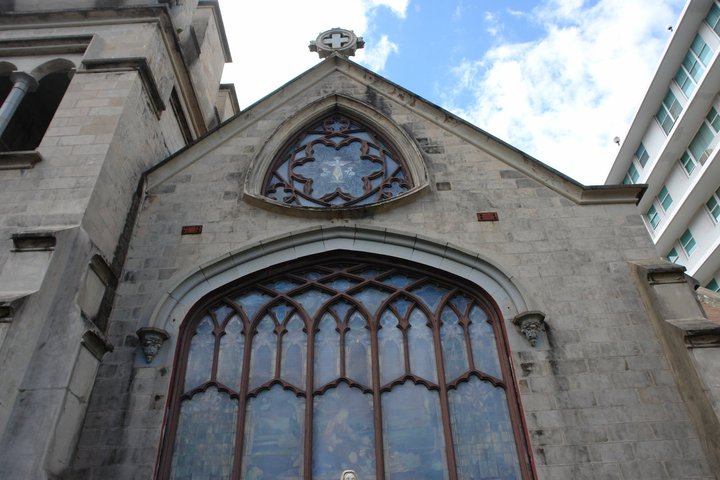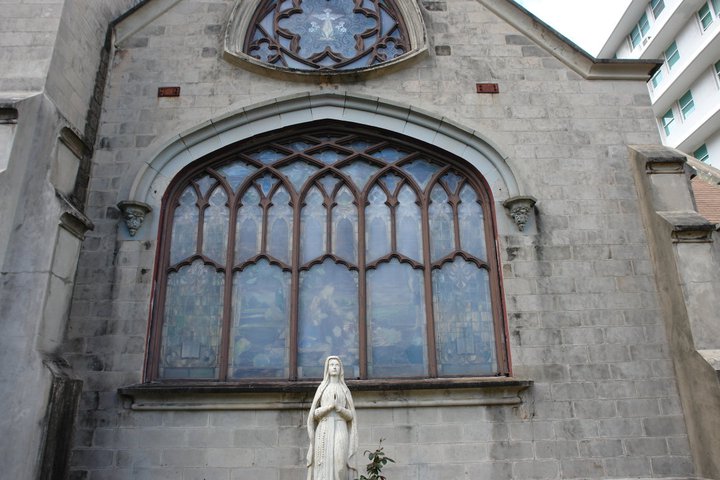English
First Episcopal Methodist Church
Nuestra Señora de Lourdes Chapel
Miramar
San Juan, Puerto Rico
Designed by: Antonín Nechodoma (1908)
Our Lady of Lourdes Chapel is located in Miramar, Santurce, a sector adjacent to the islet of San Juan. This neo-Gothic style chapel was one of the structures designed by famed Czech architect Antonín Nechodoma.
It was inaugurated in 1908 as Methodist: protestant religious doctrine that formed in England in the 18th century. Episcopal Church. Later, it passed into the hands of the Union Church of Puerto Rico and, finally, to the Roman Catholic Church.
Originally, the San Juan Methodist community, which had congregated in Puerto Rico since 1900, met in a temporary structure until 1906, when it acquired the lot where the church was built.
Czech architect Antonín Nechodoma, who lived in Puerto Rico, was in charge of the design of the temple. Construction began in 1907 and was completed in 1908, the same year it was inaugurated. In 1907, the building passed into the hands of the Union Church of Puerto Rico, a new church that combined both the Methodist Episcopal congregation and the Methodist Presbyterian congregation of Old San Juan; an association of people for purposes of worship or charity. The idea behind this union was to create a church that could bring together Christians of all denominations, especially those who spoke English.
Over the years, the structure became very small for the growing unionist congregation, so it was decided to relocate to Isla Verde and sell the church building in Miramar. The Catholic Church acquired the temple in February of 1959 and named it Our Lady of Lourdes Chapel, ascribing it to the San Juan Archdiocese.
Nechodoma's design displays neo-Gothic characteristics such as the towers at the entrance, the use of the pointed arch, the gargoyles, the stained glass windows, the texture of the stones, and the buttresses. The reinforced concrete structure was given a rustic finish that resembles stone. An iron fence encircles the garden and separates the building from its immediate surroundings.
The building has a nave with a hexagonal apse; part of the temple that has a vaulted ceiling and is commonly semicircular in shape and extends from the main façade. The altar and presbytery are located there and an annex on one side. Each of these spaces has a portico entrance. Both the main nave and the annex have a wooden roof with two gables. The church's main façade is dominated by a square bell tower that is divided into three horizontal bands: the entrances, the bell area, and the peak, which is crowned with gargoyles and battlements. The gargoyles are not only decorative elements, but also serve as water drainage for the roof. On the wall of the façade are a huge window and a stained glass rose window, as well as a Celtic cross that crowns the pinnacle of the end of the gable. The floor is finished in stone from the island.
The original structure has not undergone major alterations. The structure has been listed on the United States Department of Interior's National Register of Historic Places since 1984.
Adapted by the PROE Editorial Group Catálogo de Propiedades, Registro Nacional de Lugares Históricos, Oficina Estatal de Conservación Histórica, Oficina del Gobernador, 1995
Español
Primera Iglesia Episcopal Metodista
Capilla Nuestra Señora de Lourdes
Miramar
San Juan, Puerto Rico
Diseñado por: Antonín Nechodoma (1908)
Capilla de nuestra señora de Lourdes se encuentra en Miramar, Santurce, un sector adyacente a la isla de San Juan. Esta capilla de estilo neogótico fue una de las estructuras diseñadas por el famoso arquitecto checo; Antonín Nechodoma.
Fue inaugurado en 1908 como Metodista: doctrina religiosa protestante que se formó en Inglaterra en el siglo XVIII. Iglesia Episcopal. Más tarde, pasó a manos de la iglesia “Union Chrurch” de Puerto Rico y, finalmente, a la iglesia católica romana.
Originalmente, la comunidad Metodista de San Juan, que se había congregado en Puerto Rico desde 1900, se reunieron en una estructura temporal hasta 1906, cuando adquirió el terreno donde se construyó la iglesia.
Arquitecto checo Antonín Nechodoma, que vivió en Puerto Rico, estuvo a cargo el diseño del templo. La construcción comenzó en 1907 y se completó en 1908, el mismo año que fue inaugurado. En 1907, el edificio pasó a manos de la iglesia “Union Chrurch” de Puerto Rico, una nueva iglesia que combinó la congregación Episcopal Metodista y la congregación Presbiteriana Metodista del viejo San Juan; una asociación de personas con fines de culto o de caridad. La idea detrás de esta Unión era crear una iglesia que podría reunir a los cristianos de todas las denominaciones, especialmente aquellos que hablaban a inglés.
Con los años, la estructura se convirtió en muy pequeña para la creciente congregación unionista, así que se decidió trasladar a Isla Verde y vender el edificio en Miramar de la iglesia. La iglesia católica adquirió el templo en febrero de 1959 y le asignó el nombre de la Capilla de Nuestra Señora de Lourdes, y la asignan a la Arquidiócesis de San Juan.
Diseño de Nechodoma exhibe características de estilo neogótico como las torres de la entrada, el uso de las gárgolas, los vitrales, el arco apuntado, la textura de las piedras y los contrafuertes. La estructura de hormigón armado le fue dada un acabado rústico que se asemeja piedra. Una verja de hierro rodea el jardín y separa el edificio de su entorno inmediato.
El edificio consta de una nave con un ábside hexagonal; parte del templo que tiene un techo abovedado y es comúnmente semicircular en forma y se extiende desde la fachada principal. El altar y el presbiterio están situado allí y un anexo de un lado. Cada uno de estos espacios tiene una entrada de pórtico. Tanto la nave principal y el anexo tienen un techo de madera a dos aguas. Fachada principal de la iglesia está dominada por un campanario cuadrado que se divide en tres bandas horizontales: las entradas, la zona de campana y el pico, que está coronado con gárgolas y almenas. Las gárgolas no sólo son elementos decorativos, pero también sirven como drenaje del agua del techo. En la pared de la fachada hay un gran ventanal con un rosetón de vitral, así como una Cruz celta que corona la cima del final del frontón. El piso está terminado en piedra de la isla.
La estructura original no ha sufrido alteraciones importantes. La estructura ha sido incluida en registro nacional de lugares del Departamento del Interior Estados Unidos históricos desde 1984.
Adaptado por el Grupo Editorial PROE
Catálogo de Propiedades, el Registro Nacional de Lugares Históricos, la Oficina Estatal de Conservación Histórica, Oficina del Gobernador, 1995













